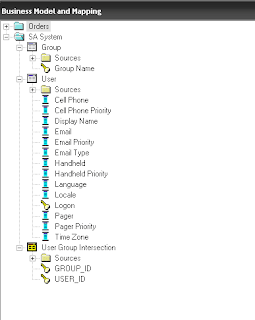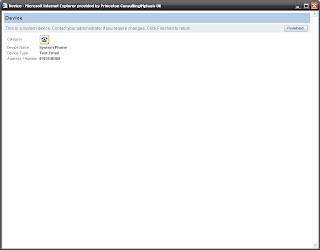So, just back from the launch day for OBIEE 11g, lots of good stuff there, although I have to say that after this long in development I was hoping for a bit more, especially for developers. When one of the people giving a session opened the Admin tool and I saw that it was pretty much exactly the same with new icons my heart did sink a little bit.
Anyway, here are the notes I made, and a few blurry pictures from my iPhone, sorry still getting used to it ...
Visualisation:
- Geospatial support, ie results shown on map without any extra config, probably separately licensed says my sceptical self.
- Scorecards, kpi watchlist , strategy trees etc; these are all new and look very powerful, again the implication was separate licensing.
- Complete integration of bi publisher and
- Complete control of the whole from enterprise manager
- Pivot tables can be re- pivoted in place by the user; huge win in my mind
- Comments against the strategy tree explaining problems etc, collaboration, not so sure about this one.
- Geospatial support, ie results shown on map without any extra config, probably separately licensed says my sceptical self.
- Scorecards, kpi watchlist , strategy trees etc; these are all new and look very powerful, again the implication was separate licensing.
- Complete integration of bi publisher and
- Complete control of the whole from enterprise manager
- Pivot tables can be re- pivoted in place by the user; huge win in my mind
- Comments against the strategy tree explaining problems etc, collaboration, not so sure about this one.
From insight to action:
- Action links have the traditional navigate etc options but also allow custom actions. These actions can be all sorts of navigation, call web service, java method, browser script or http method. Guided navigation still available on these links.
- Can have saved actions which we then just pick out as action for link. So actions are now first class objects that are saved and shared.
- Can add commentaries to dashboards etc for collaboration, maybe useful if going to sharepoint or something.
Dashboard editor is much prettier.
iBots now called Agents. Other than that not very different for delivers section except for actions which now allows the full list as above and use of the action library. Also have invoke per row so that action is triggered for each row in the report instead of for the whole result set.
Systems management and deployment:
- Centralised performance management.
- Pull logs from all components on all servers to one log and trace an error or query all the way through it.
- Usage tracking and delivers etc schemas are created at point of installation with repository creation utility.
- Oracle Process Management Notification now used for controlling non j2ee comps i.e. BI server etc. All j2ee comps now controlled via weblogic which is included in the installation. EM can be used to configure everything now for 11g.
Security things: pluggable SSO and ID management. SSL everywhere can be configured in one place and then starts working between all components just like that.
3 install options, simple, enterprise (pick ports network install etc) and software only for just lying out software and not doing the configuration.
Very simple 10g to 11g upgrade experience multipass so that you can check what is going to happen etc before doing it. Upgrades data and schema and all pieces eg webcat.
EM is very good now. No more searching for logs etc all in one place no more configuration files either.
Can also see performance metrics for the environment e.g. Number of queries, new logins by time.
6 weeks till GA of OBIEE11G
Security things: pluggable SSO and ID management. SSL everywhere can be configured in one place and then starts working between all components just like that.
3 install options, simple, enterprise (pick ports network install etc) and software only for just lying out software and not doing the configuration.
Very simple 10g to 11g upgrade experience multipass so that you can check what is going to happen etc before doing it. Upgrades data and schema and all pieces eg webcat.
EM is very good now. No more searching for logs etc all in one place no more configuration files either.
Can also see performance metrics for the environment e.g. Number of queries, new logins by time.
6 weeks till GA of OBIEE11G













